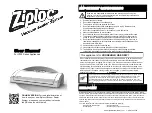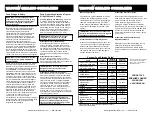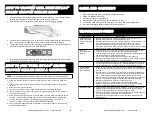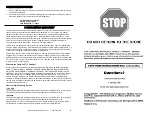
www.ziplocvacuumsealer.com 1-888-723-5198
2
VACUUM SEALING GUIDELINES
Food Storage & Safety
IMPORTANT: Vacuum packaging is NOT a
substitute for refrigeration or freezing. Any
perishable foods that require refrigeration
must still be refrigerated or frozen after
vacuum packaging.
For best results in extending the life of foods, it is
important to vacuum package foods that are
fresh. Once food has begun to deteriorate,
vacuum packaging may only slow the
deterioration process. Vacuum sealing cannot
prevent the growth of mold. Other disease
causing microorganisms can still grow in low
oxygen environments and may require further
measures to be eliminated.
Yeast
- The
development of yeast can be slowed by
refrigeration and completely stopped by freezing
food at 0°F(-18°C).Yeast causes fermentation,
which gives food an identifiable smell.
Bacteria
-
Bacteria can grow rapidly in the “
Danger Zone
”,
the temperatures between 40ºF (4°C) and 140ºF
(60°C). Pathogenic bacteria cause illness and do
not generally affect the taste, smell or appearance
of food. They are rare, but can be very dangerous.
IMPORTANT: There are basic rules to follow
when handling food: COOK, SEPARATE,
CLEAN and CHILL.
Cook
– It is crucial to cook food to a safe internal
temperature to destroy bacteria that is present.
Bacteria is not just a surface condition but can be
found deep within the mixture of meats and other
foods.
Separate
- Foods that will be eaten
uncooked and foods that will be cooked before
eating MUST ALWAYS be kept separate. Cross
contamination can occur when raw foods (such
as meats or eggs) come in contact with foods
that will be eaten before or after cooking. Always
use your Ziploc
®
Brand Vacuum Sealer Bags to
ensure that juices won’t drip onto fresh produce
or other foods.
Clean
– Wash hands and work
surfaces frequently when cooking. Wash with
soap and water for at least 15 seconds, then dry
with a paper towel.
Chill
- Chilling food is very
important. To help preserve food safely, do not
allow food to stand at room temperature for 2
hours or more. Set your refrigerator to 40°F (4°C)
or colder and your freezer to 0°F (-17°C).
Freezing at 0°F (-17°C). does not kill
microorganisms, but stops them from growing. For
long-term storage, always freeze perishable foods
that have been vacuum packaged and keep
refrigerated after packaging.
Food Preparation Hints and Tips for
Airtight Vacuum Sealing
Cooking, Thawing and Reheating
- Simmering
in a Ziploc
®
Brand Vacuum Sealer Bag helps
food retain its flavor and helps with the clean up
as well. When reheating foods in the microwave
that have been stored in Ziploc
®
Brand Vacuum
Sealer Bags, puncture the bag to allow hot air to
escape. You can also reheat foods in Ziploc
®
Brand Vacuum Sealer Bags by placing them in
water at a low simmer below 170°F (75°C).
IMPORTANT: Always thaw food in either
refrigerator or microwave - do not thaw
perishable foods at room temperature.
Preparation Hints for Meat and Fish:
Pre-freeze meat and fish for 1-2 hours before
vacuum packaging. This helps retain the juice
and shape, providing a better seal. If you cannot
pre-freeze, place a folded paper towel between
the food and top of the bag, but below seal area.
Leave paper towel in bag to absorb excess
moisture and juices during vacuum packaging
process.
Preparation Hints for Cheeses:
Buy fresh and keep fresh, that’s our motto!
Vacuum package cheese after each use. If you
make your bag just a little longer than needed, you
can reseal the bag after each use.
IMPORTANT: Due to the risk of anaerobic
bacteria, soft cheeses should never be
vacuumed packaged.
Preparation Guidelines for Vegetables:
Mom always said
“eat your vegetables..”,
we say
blanch them. Blanching is a process that should
be done before vacuum packaging. This process
stops the enzyme action that could lead to loss of
flavor, color and texture. To blanch vegetables,
place them in simmering water or in a microwave
until they are cooked, but still crisp. Blanching
times can range from 1 to 2 minutes for leafy
greens and peas; 3 to 4 minutes for snap peas,
sliced zucchini or broccoli; carrots about 5
minutes; and 7 to 11 minutes for corn on the cob.
After blanching, immerse vegetables in cold water
to stop the cooking process.
NOTE: All vegetables (including broccoli,
brussels sprouts, cabbage, cauliflower, kale,
turnips etc.) naturally emit gases, during
storage. Therefore, after blanching, it’s best
if they are stored in the freezer.
3
www.ziplocvacuumsealer.com 1-888-723-5198
More on Vegetables:
Vegetables are a great candidate for portion
control; when storing vegetables, try pre-
freezing them for 1 to 2 hours, then separate
them into meal portions within your Ziploc
®
Brand Vacuum Sealer Bags. After they have
been vacuum packaged, return them to the
freezer.
IMPORTANT: Due to the risk of anaerobic
bacteria, fresh mushrooms, onions & garlic
should never be vacuum packaged.
Preparation Hints for Powdery Foods:
When vacuum packaging powdery items like
flour, it’s best to use their original packaging
inside of the Ziploc
®
Brand Vacuum Sealer
Bags. The fine powder could get sucked into
the machine and cause enough damage to
shorten the life of the sealer.
Preparation Hints for Liquids:
Before vacuum packaging liquids such as
soup stock, pre-freeze in a casserole dish, loaf
pan or ice cube tray until solid. Remove
frozen liquid from the pan and vacuum
package in a Ziploc
®
Brand Vacuum Sealer
Bag. Then store in the freezer. When ready to
use, simply cut the corner of the bag and place
with the cut corner up in either a microwave
dish or drop into water at a low simmer, below
170ºF (77ºC).
Preparation Guidelines for Healthy
Make-Ahead Meals:
Ziploc® Brand Vacuum Sealer Bags are very
effective in helping you plan and prepare
healthy make-ahead meals. Check out the
recipes contained on our website for additional
ideas.
VACUUM SEALING GUIDELINES
Vacuum Food Storage Guide*
Food
Stored In
Normal
Shelf Life
Vacuum
Shelf Life
Large cuts of meat: beef,
poultry, lamb and pork
Freezer
6 months
2-3 years
Ground meat: beef,
poultry, lamb and pork
Freezer
4 months
1 year
Fish
Freezer
6 months
2 years
Coffee beans
Pantry
4 weeks
16 months
Coffee beans
Freezer
6-9
months
2-3 years
Berries: strawberries,
raspberries, blackberries
Refrigerator
1-3 days
1 week
Berries: cranberries,
huckleberries,
blueberries
Refrigerator
3-6 days
2 weeks
Cheese
Refrigerator
1-2 weeks
4-8 months
Cookies, crackers
Pantry
1-2 weeks
3-6 weeks
Flour, sugar, rice
Pantry
6 months
1-2 years
Lettuce
Refrigerator
3-6 days
2 weeks
Nuts
Pantry
6 months
2 years
Oils with no
preservatives, like
safflower, canola, corn
oil
Pantry
5-6
months
1-1.5 years
Wine
Refrigerator
1-3 weeks
2-4 months
Table adapted from Dr. G.K. York, Dept. of Food Science & Tech.,
University of California, Davis
* Only use information on this table
as a guideline! Actual storage
life may vary. Check all food for
spoilage before use.
FOOD STAYS
FRESHER LONGER
WHEN YOU
VACUUM SEAL!


























